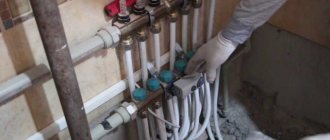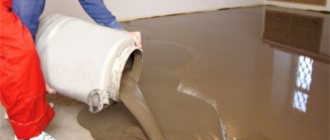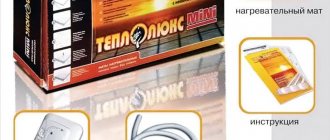The popularity of individual heating systems , called underfloor heating, is constantly growing. It's convenient, comfortable and not too expensive. But the main thing that interests everyone is the control of heated floors. Constant operation of this system is effective, but not very economical, so the ability to turn the floor on and off and change the heating level is very important for such a system. Heated floor control can be carried out in forced, automatic or remote mode.
Ability to control water heated floors
There are currently two underfloor heating systems in use:
- With liquid coolant
- Electric
Plain water is usually used as a coolant. Controlling the temperature of a water floor is technically implemented using more complex methods than controlling electric floors. Such warm floors are usually used in private homes where there is an individual gas boiler.
A regular valve is installed on each circuit, with the help of which the flow of hot water is regulated. Thus, the temperature is set manually.
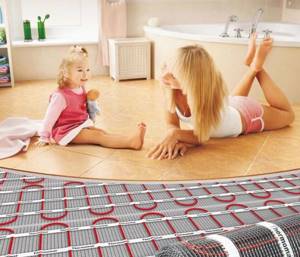
Automatic control mode
In automatic mode, each room has its own circuit and thermostat, where the desired temperature mode for a given room is selected. Each circuit is equipped with a servo drive that changes the flow of coolant , thereby regulating the temperature in the room.
Structurally, it looks like this. Each room has a temperature sensor that constantly measures its value at a certain point and transmits data to the heated floor control unit, the core of which is a programmable controller. If the air temperature changes from the specified limit, the controller sends a command to the servo drive, which regulates the flow of coolant into the system. changes to the specified level . A timer is connected to the controller, which allows you to program the temperature in each room depending on the time of day.
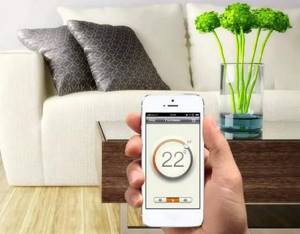
Heated floors can also be controlled remotely. Typically, water heating systems in private homes are made using a two-pipe circuit with a circulation pump, so the simplest remote heating control system includes a GSM socket to which the pump is connected. It is impossible to regulate the temperature in this way, but it is quite possible to turn the heated floor on or off using a command from a mobile device. When the circulation pump is turned off, the coolant returns through the bypass without entering the heated floor circuits.
Ready solution - Salusi T600 Smart Home
The Salusi T600 SmartHome complex can be considered a universal heating control system. This is a ready-made Smart Home solution that performs all the necessary functions, including controlling heated floors. The Salus system provides remote control of heated floors or heating radiators via the Internet or from a smartphone using a special application. There are two versions of the system, one of which involves laying wired lines between the elements, and in the other, communication between the temperature sensors, controller and servo drive is carried out via a radio channel.
Custom controllers

Heated floors are controlled by installing sensors that regulate the intensity of air heating in the room and are able to maintain the heating temperature at a given level.
Device operation diagram:
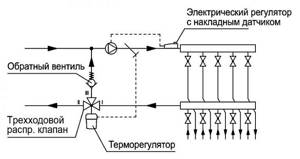
The owner sets certain parameters for the thermostat. When the temperature rises or falls, the device turns the water heating system on or off.
Electric floor heating control
Electric heated floors, thanks to their design features, are much easier to control using various remote systems. For an electric heated floor, you only need a 220 V network and a control device. The easiest way to control an electric heated floor is through a smart socket using “on-off” commands from any mobile device.
Regulators are available in several different designs:
- Electromechanical
- Digital
- Programmable
Electromechanical regulators allow you to regulate the heating of the heated floor manually. On the body of the device there is a temperature regulator that can be set to the required value. Such a device is very reliable and inexpensive , and in case of breakdown it is easily repaired. The digital controller performs the same functions, but is made on a modern element base and has touch buttons.
The most versatile device is a programmable thermostat . This is a full-fledged multifunctional device that can be integrated into a comprehensive Smart Home control system. Temperature sensors are connected to such a device, and the built-in controller controls floor heating using a dimmer. The system allows you to maintain a set temperature in one room.
Thermostat MCS 350
The MCS 350 thermostat can be considered a successful solution for domestic use. The Teplolux Premium system is used to control various heating systems. The heated floor can be controlled from a touch wall panel and from any mobile device on which the appropriate application is installed. The device operates on a Wi-Fi network through a home router.
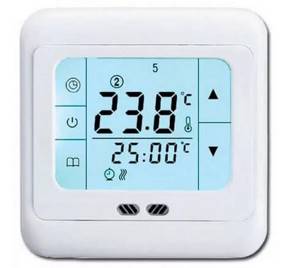
A home network allows you to combine up to 32 regulators , which will provide all rooms of a large house with a comfortable temperature. The delivery set includes two temperature sensors, one of which is located on the wall, and the other sensor has direct contact with the heated floor. This connection scheme provides temperature control according to two parameters. Using the MCS 350 thermostat, due to rational temperature control, allows you to save energy.
Useful video on setting up a thermostat
Automatic temperature control of TP
Automatic adjustment of a heated floor can be carried out thermomechanically or electronically using electromechanical actuators that control the operation of shut-off valves.
Thermomechanical control system
It is based on the operation of thermostatic valves or taps with thermal heads that respond to changes in coolant temperature. Various models of such shut-off and control valves are offered today by many manufacturers, for example, Oventrop. However, regardless of the name and type of thermosetting substance used in them (liquid or gas), these are thermomechanical self-regulating mechanisms that are most appropriately installed to control the temperature of one, individual circuit.
The operating principle of thermal valves is simple, which makes them very reliable and fault-tolerant. A copper, brass or bronze core installed in the device body, heated by the passing coolant flow, transfers the temperature to the thermosetting filler. In turn, the thermosetting element, which increases in volume, pushes the core, which, by moving the valve, gradually blocks the circulation of the heated liquid.
The thermostatic valve for heated floors, in addition to being installed on the distribution comb, can be mounted in a separate “unibox” type assembly. Such assemblies also include automatic air vents, which, together with thermostats, are placed in compact boxes (boxes). The use of a “unibox” allows you to adjust the temperature in a separate branch of the TP without being tied to bulky manifold cabinets, which is especially convenient with a small number of circuits.
In addition, thermomechanical floor heating controllers can have remote air sensitive elements. They allow you to configure them to control the flow of coolant not according to its temperature, but according to the air temperature in the rooms. The principle of their operation is the same, only the thermosetting substance is much more sensitive. It is advisable to install an air thermal head for simultaneous control of several circuits in one room, where water underfloor heating is the only source of heating.
Electronic control system
It consists of electronic thermometers, a controller and electric drives (actuators, servos). Electric drive mechanisms can be attached to the mixing heads of conventional control valves (valves) or be part of their design. The change in coolant supply intensity is carried out in accordance with specified threshold values. The measuring medium for the temperature sensors of the automatic floor heating temperature controller can be both the coolant and the air in the premises.
Important! Such control equipment is quite expensive, but at the same time it is capable of providing optimal operating conditions for underfloor heating and maximum energy savings. In addition, electronic regulators allow programming of the TP with binding of its operating modes to different time periods, which guarantees the user maximum thermal comfort.

Control of heated floors from a remote control
There are inexpensive control systems that allow you to remotely change the temperature within one room. They use an executive module and a heated floor control panel. It has a design similar to home appliance remote controls and operates on infrared rays. The TR-810 thermostat is a device that provides temperature setting in the range from + 5 to + 350C at a load of 3.5 kW and a current of up to 16 A. The remote control provides control of the TR-810 executive module at a distance of up to 25 meters. One remote control is designed to control four actuators.
Circulation pump control
This is the simplest type of control: depending on the temperature of the coolant, the pump will turn on/off.
To implement this method you do not need a lot of knowledge or special qualifications. And the “automation for heated floors” is not used here: it’s just a room thermostat and nothing more.
The circulation pump control diagram looks like this:
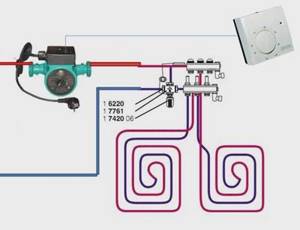
As you can see, there is a thermostat installed in any room; when the set temperature is reached, the thermostat operates and turns off or turns on the pump.
This is how you can easily control the floor temperature automatically:
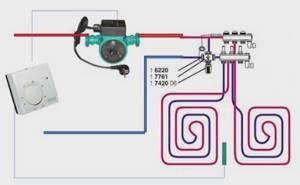
Here the thermostat monitors the readings of a sensor mounted in the floor between (and not on one pipe!) the pipes. The sensor gives a command to the thermostat, which processes the received signal and turns the circulation pump on/off.
Disadvantage: if there is one common pump for the whole house, then this method is not always suitable, because the pump is turned off by a thermostat installed in one room, and when the pump is turned off, the heating will stop throughout the house. This method is suitable if there are two pumps, for example, on different floors, and you need to control the heating on one floor without touching the second.
Why are heated floors so popular?
The main difference between water heated floor systems and radiator systems is not so much the hidden installation of the coolant circuit, although this is the basis for many advantages, but rather the lower temperature of the coolant. In European countries, these systems have successfully stood the test of time - for more than half a century, even in the northern part of the continent, they have been used as the main source of heat. Naturally, such a choice is determined solely by practicality, and not by mentality.
Maria SukharevaSpecialist at Uponor
Due to the characteristics of floor systems, we can say that they are economical, environmentally friendly and aesthetically pleasing. Low-temperature surface heating systems produce soft radiant heat and act directly on a person, without intermediate heating of the air masses in the room. This allows you to reduce the temperature in the rooms, while maintaining the required level of comfort and reducing heating costs.
And we are talking not only about comfort, but also about the preferred microclimate.
Oleg NosykForumHouse Member
The heat emitted by a heated floor is perceived many times better than convection. This is due to the biological structure of our body. According to the results of scientific research, a person experiences a feeling of comfort and warmth when the temperature at the level of his feet is slightly higher than the temperature at the level of his head. The optimal condition is when the floor surface temperature is from 20 to 29°C, and at head level – from 19 to 24°C.
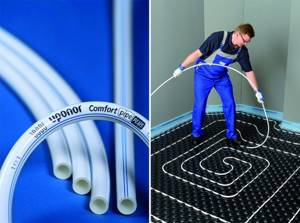
In addition to the fact that “a healthy mind is in a healthy body,” underfloor heating is also beneficial.
- From a cost point of view - although a heated floor is more expensive at the installation stage, it is more profitable during operation, due to less heating of the coolant and uniform heat distribution, energy savings vary between 12-15%.
- From a decorative point of view, only exclusive designer radiators can become an interior decoration; available standard models, at best, will not spoil the view. But even then they will create certain restrictions when decorating the interior, while a hidden heating system, on the contrary, “frees your hands.”
- From a practicality point of view, a convective heating system based on the circulation of air masses is also accompanied by the circulation of dust settling on all surfaces. And this is not only unnecessary cleaning, especially if the interior is in dark colors (not to mention the radiators themselves and the space behind them), but also an unfavorable factor for asthmatics and allergy sufferers.
Underfloor heating is chosen both to preserve aesthetics, especially when the glazing is panoramic, and to keep “your feet warm and your head cold,” and in the hope of staying in the black over the years. The effectiveness of water heated floors has been proven by practice - the bulk of built or reconstructed country houses today are heated primarily by a combined system, heated floors and radiators, or only heated floors. Moreover, multi-storey buildings in residential complexes began to be equipped with similar systems as the only source of heat.
Maria SukharevaSpecialist at Uponor
To increase the level of comfort of residents, create an optimal microclimate and reduce heating costs, a water heated floor system was chosen for one of the residential complexes in St. Petersburg. On average, this reduced energy consumption in apartments by 20%.
System parameters:
- The pipes used are cross-linked polyethylene PE-Xa 17×2.0 (with an anti-diffusion layer).
- Laying - spiral (to ensure uniform heat transfer).
- The pitch of laying loops is 200 mm and 100 mm (above windows and end walls).
For maximum efficiency, the systems are equipped with automatic control systems.
The bulk of the problems attributed to water heated floors (zebra crossing, hot/cold, leaks, etc.) are not related to shortcomings of the system as such, but to design errors, low-quality components or violations of installation technology.
Thermal head control
Let's say there is a mixing unit with a three-way valve in front of the manifold:
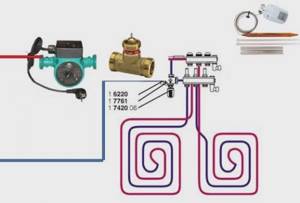
A thermal head is screwed onto this valve, to which a temperature sensor is connected. The sensor is installed on the pipe in which we want to control the temperature (it can be directly on the supply or return manifold). And we set the temperature we need on the thermal head. Now, based on a signal from the sensor, the thermal head will close or open the three-way valve, thereby adjusting the temperature of the coolant to, again, the desired parameter.
